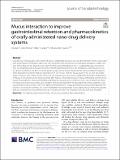Mucus interaction to improve gastrointestinal retention and pharmacokinetics of orally administered nano-drug delivery systems
Author(s)
Subramanian, Deepak A.; Langer, Robert; Traverso, Giovanni
Download12951_2022_Article_1539.pdf (1.510Mb)
Publisher with Creative Commons License
Publisher with Creative Commons License
Creative Commons Attribution
Terms of use
Metadata
Show full item recordAbstract
Abstract
Oral delivery of therapeutics is the preferred route of administration due to ease of administration which is associated with greater patient medication adherence. One major barrier to oral delivery and intestinal absorption is rapid clearance of the drug and the drug delivery system from the gastrointestinal (GI) tract. To address this issue, researchers have investigated using GI mucus to help maximize the pharmacokinetics of the therapeutic; while mucus can act as a barrier to effective oral delivery, it can also be used as an anchoring mechanism to improve intestinal residence. Nano-drug delivery systems that use materials which can interact with the mucus layers in the GI tract can enable longer residence time, improving the efficacy of oral drug delivery. This review examines the properties and function of mucus in the GI tract, as well as diseases that alter mucus. Three broad classes of mucus-interacting systems are discussed: mucoadhesive, mucus-penetrating, and mucolytic drug delivery systems. For each class of system, the basis for mucus interaction is presented, and examples of materials that inform the development of these systems are discussed and reviewed. Finally, a list of FDA-approved mucoadhesive, mucus-penetrating, and mucolytic drug delivery systems is reviewed. In summary, this review highlights the progress made in developing mucus-interacting systems, both at a research-scale and commercial-scale level, and describes the theoretical basis for each type of system.
Date issued
2022-08-06Department
Massachusetts Institute of Technology. Department of Chemical Engineering; Koch Institute for Integrative Cancer Research at MITPublisher
BioMed Central
Citation
Journal of Nanobiotechnology. 2022 Aug 06;20(1):362
Version: Final published version